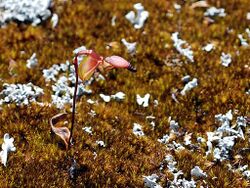Biology:Caleana granitica
| Granite duck orchid | |
|---|---|

| |
| Scientific classification | |
| Kingdom: | Plantae |
| Clade: | Tracheophytes |
| Clade: | Angiosperms |
| Clade: | Monocots |
| Order: | Asparagales |
| Family: | Orchidaceae |
| Subfamily: | Orchidoideae |
| Tribe: | Diurideae |
| Genus: | Caleana |
| Species: | C. granitica
|
| Binomial name | |
| Caleana granitica (Hopper & A.P.Br.) M.A.Clem.[1]
| |
| Synonyms[2] | |
| |
Caleana granitica, commonly known as the granite duck orchid[3] is a species of orchid that is endemic to the south-west of Western Australia. It is a species of duck orchid with a single smooth leaf and a single greenish yellow and red flower with the labellum held below the horizontal. It grows on a single granite outcrop near Armadale.
Description
Caleana granitica has a single smooth, dull green to dull red leaf, 10–20 mm (0.4–0.8 in) long and 2–4 mm (0.08–0.2 in) wide. The leaf is usually withered by flowering time. Usually only one greenish-yellow and red flower, 20–25 mm (0.8–1 in) long and 10–12 mm (0.4–0.5 in) wide is borne on a flowering stem 40–70 mm (2–3 in) high. The dorsal sepal, lateral sepals and petals are narrow and hang downwards with the dorsal sepal pressed against the column which has broad wings, forming a bucket-like shape. The labellum has a flattened top and is held below horizontal with one-half to one-third of its outer part covered with glossy black glands or calli. Flowering occurs from October to early December.[3][4]
Taxonomy and naming
The granite duck orchid was first formally described in 2006 by Stephen Hopper and Andrew Brown who gave it the name Paracaleana granitica and published the description in Australian Systematic Botany.[5] In 2014, based on molecular studies, Joseph Miller and Mark Clements transferred all the species previously in Paracaleana to Caleana so that the present species became Caleana granitica.[1][6] The specific epithet (granitica) refers to the granite outcrop where this orchid grows.[3][4]
Distribution and habitat
Caleana granitica grows with mosses and lichens on a granite outcrop south of Armadale in the Jarrah Forest biogeographic region.[3][4][7]
Conservation
Caleana granitica (as Paracaleana granitica) is classified as "Priority One" by the Government of Western Australia Department of Parks and Wildlife,[7] meaning that it is known from only one or a few locations which are potentially at risk.[8]
References
- ↑ 1.0 1.1 "Caleana granitica". APNI. https://id.biodiversity.org.au/instance/apni/3691644. Retrieved 16 April 2018.
- ↑ "Caleana granitica". World Checklist of Selected Plant Families (WCSP). Royal Botanic Gardens, Kew. http://wcsp.science.kew.org/namedetail.do?name_id=489583.
- ↑ 3.0 3.1 3.2 3.3 Hoffman, Noel; Brown, Andrew (2011). Orchids of South-West Australia. (3rd ed.). Gooseberry Hill: Noel Hoffman. p. 256. ISBN 9780646562322.
- ↑ 4.0 4.1 4.2 Brown, Andrew; Dundas, Pat; Dixon, Kingsley; Hopper, Stephen (2008). Orchids of Western Australia. Crawley, Western Australia: University of Western Australia Press. p. 302. ISBN 9780980296457.
- ↑ "Paracaleana granitica". APNI. https://id.biodiversity.org.au/instance/apni/608581. Retrieved 16 April 2018.
- ↑ Miller, Joseph T.; Clements, Mark A. (2014). "Molecular phylogenetic analyses of Drakaeinae: Diurideae (Orchidaceae) based on DNA sequences of the internal transcribed spacer region". Australian Systematic Botany 27 (1): 3–22. doi:10.1071/SB13036. http://www.publish.csiro.au/SB/fulltext/SB13036. Retrieved 16 April 2018.
- ↑ 7.0 7.1 "Paracaleana granitica". FloraBase. Western Australian Government Department of Parks and Wildlife. https://florabase.dpaw.wa.gov.au/browse/profile/23475.
- ↑ "Conservation codes for Western Australian Flora and Fauna". Government of Western Australia Department of Parks and Wildlife. https://www.dpaw.wa.gov.au/images/documents/plants-animals/threatened-species/Listings/Conservation%20code%20definitions.pdf. Retrieved 28 October 2019.
Wikidata ☰ {{{from}}} entry
 |


